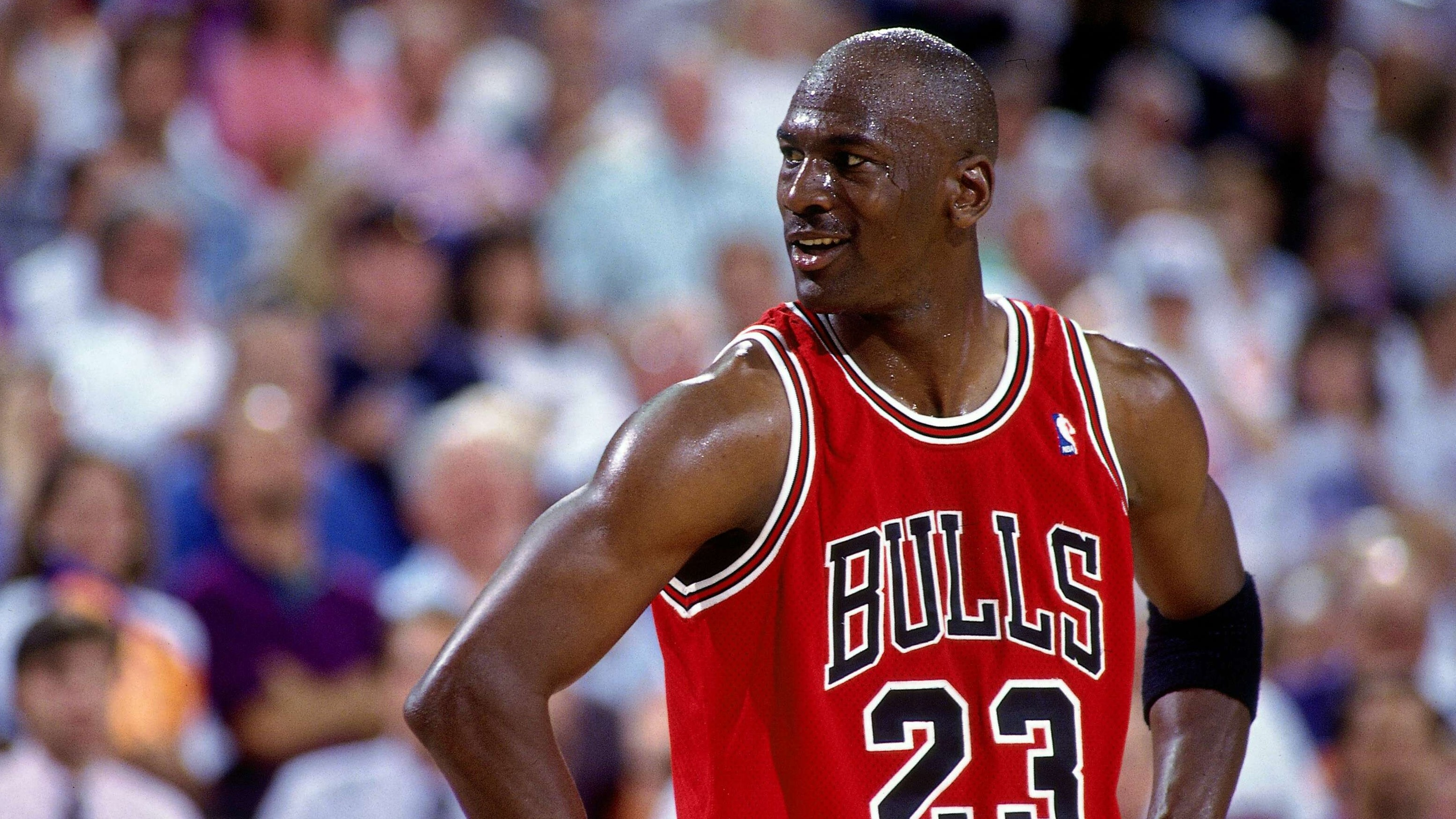
Michael Jordan of the Chicago Bulls in Game 1 of the NBA Finals against the Phoenix Suns at the America West Arena in Phoenix, Arizona, June 9, 1993. /VCG
Michael Jordan of the Chicago Bulls in Game 1 of the NBA Finals against the Phoenix Suns at the America West Arena in Phoenix, Arizona, June 9, 1993. /VCG
In the summer of 1992, two-time NBA champion Michael Jordan added another honor to his name: the men's basketball gold medal at the Summer Olympics in Barcelona. It's the second time he won it after Los Angeles in 1984 but the victory in Spain was different because he accomplished it as a member of the famous "Dream Team," one of Team USA's greatest basketball squads in history.
After the Olympics, Jordan was ready to chase his third title in a row – only two teams had done it before, the Minneapolis Lakers in the 1950s and the Boston Celtics in the 1960s.
As one of the most successful coaches in NBA history, Pat Riley tasted that hardship by himself and knew that it's championship that killed the champion. After you win the title, it can be easy to lose the motivation and persistence to do whatever it takes to win.
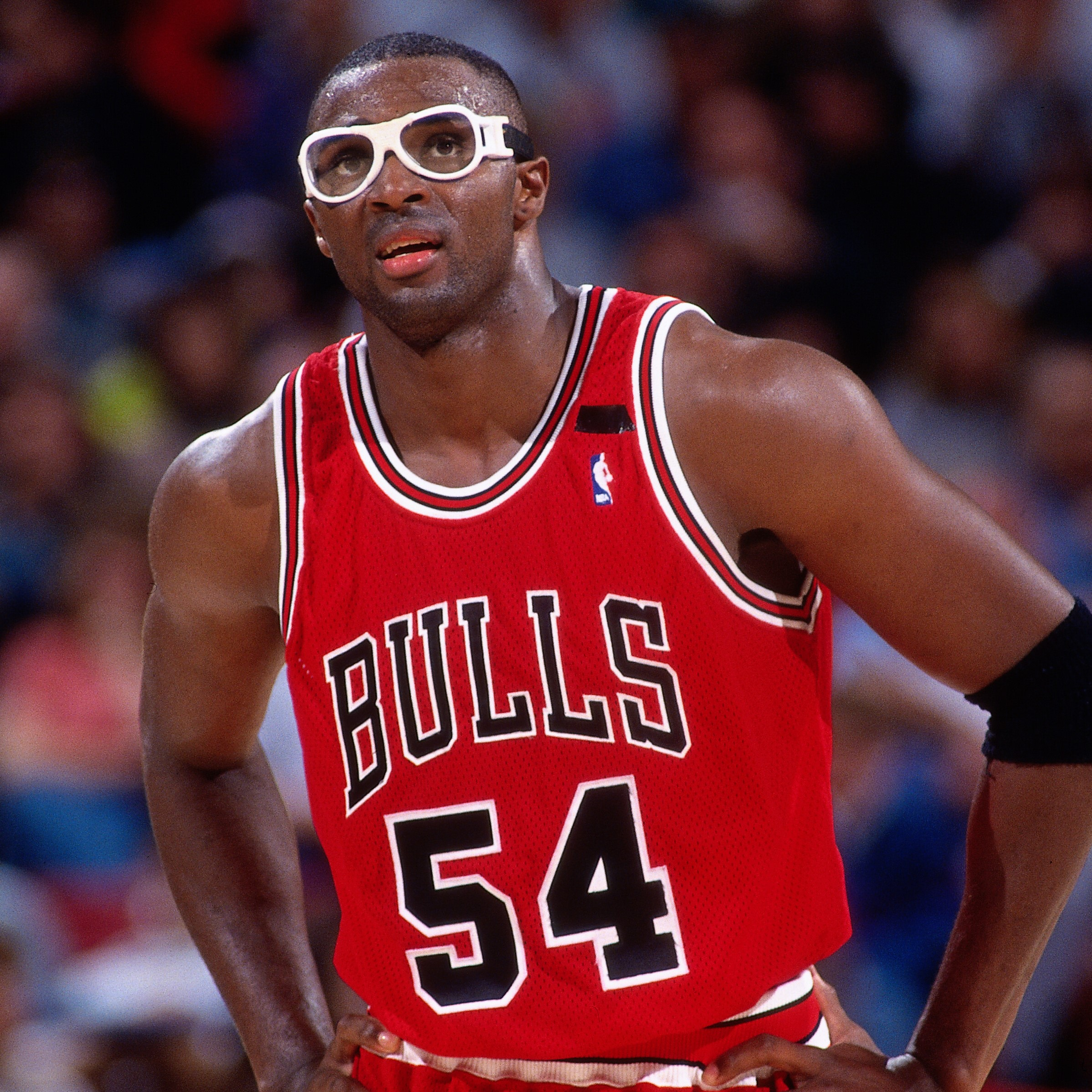
Horace Grant of the Chicago Bulls in the game against the Sacramento Kings at Arco Arena in Sacramento, California, U.S., November 21, 1993. /VCG
Horace Grant of the Chicago Bulls in the game against the Sacramento Kings at Arco Arena in Sacramento, California, U.S., November 21, 1993. /VCG
Jordan soon felt something was wrong with the team.
Horace Grant, the third-most important player of the Bulls was unhappy with the privilege enjoyed by Jordan and Scottie Pippen. He complained to the press that they had to do the boring, exhausting practice in the gym while Jordan and Pippen could skip and rest at home.
Jordan and Pippen took an extra week-long leave because they needed to recover from the Olympic fatigue.
Then in the first town months of the 1992-93 season, the Bulls were 18-7 and Jordan already dropped 50+points in two games – he only had two of such games in the previous two seasons. Then on January 16, 1993, the Orlando Magic and first-year rookie Shaquille O'Neal came to the United Center. The 2.16-meter-tall, 140+ kilogram monster humiliated the Bulls' big men by putting down 29 points, 24 rebounds and five blocks. Jordan took 49 shots to get 64 points, the first time he reached 60+ since 1990 and the last time in his career.
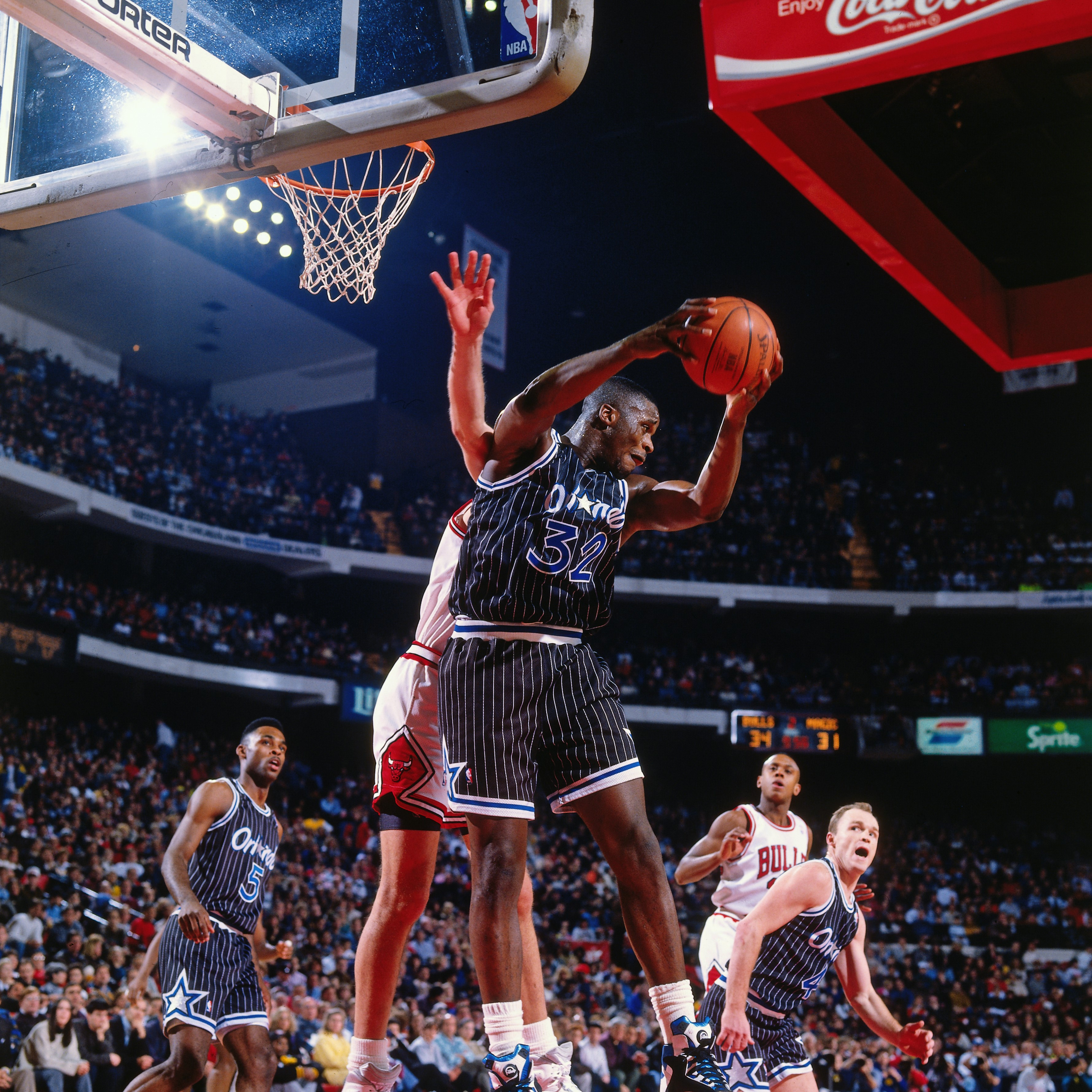
Shaquille O'Neal #32 of the Orlando Magic takes a rebound in the game against the Chicago Bulls at the United Center in Chicago, Illinois, U.S., January 16, 1993. /VCG
Shaquille O'Neal #32 of the Orlando Magic takes a rebound in the game against the Chicago Bulls at the United Center in Chicago, Illinois, U.S., January 16, 1993. /VCG
However, the Bulls lost 128-124 in overtime. Moreover, they went 7-8 for the whole month, though they never lost three games in a row, such disappointing performance should alert everyone.
Three months later, Chicago finished the regular season with a 57-25 record, they failed to reach 60 wins for the first time in three years. Jordan played 39.3 minutes per game, the most since 1989, and averaged 32.6 points, the highest in all his championship years. He also claimed the seventh scoring title, matching Wilt Chamberlain's record and the third steals leader.
Nonetheless, this time he was not the NBA MVP, the award went to Charles Barkley who would wait for him in the Finals with the 62-20 Phoenix Suns.
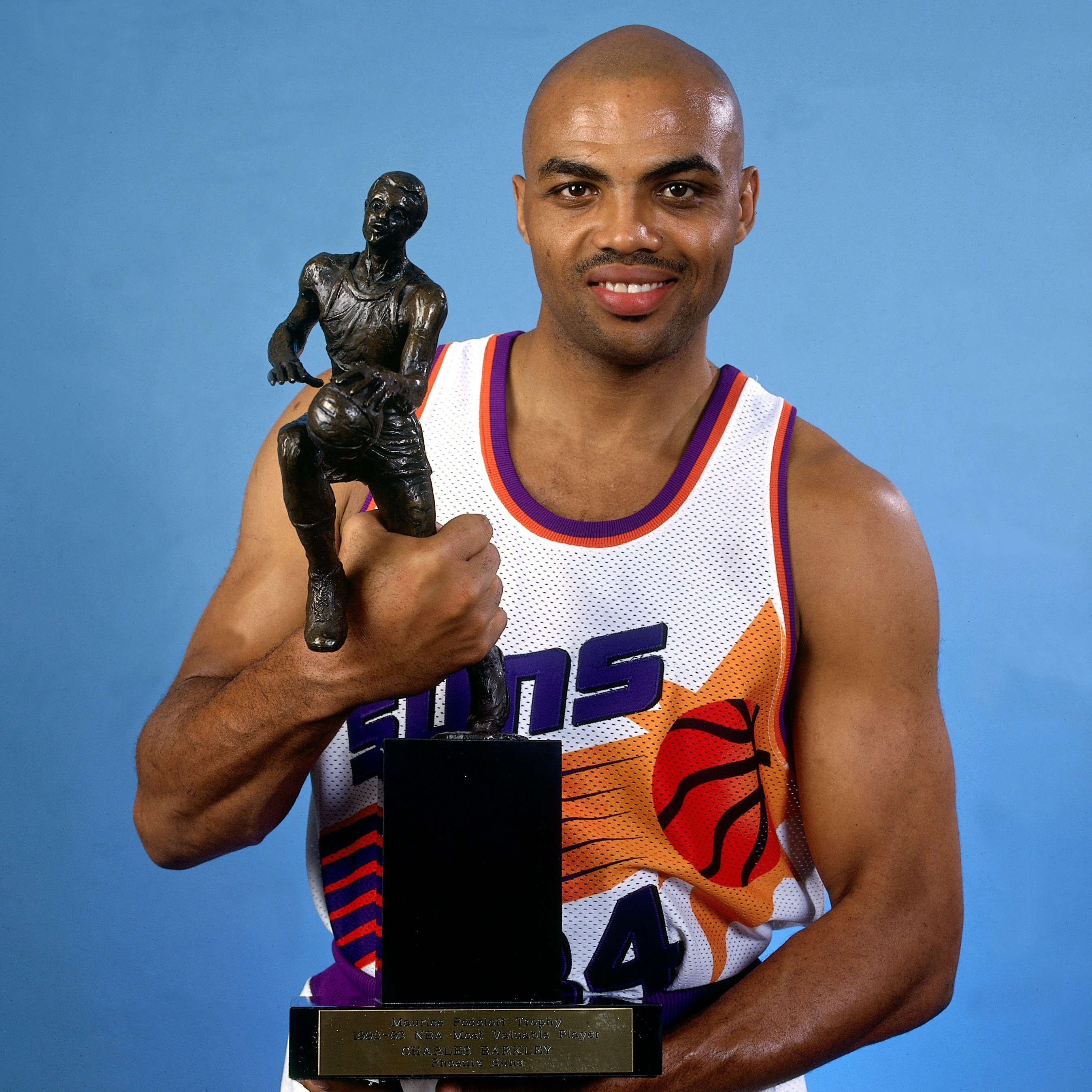
Charles Barkley of the Phoenix Suns holds the NBA MVP trophy for a portrait. /VCG
Charles Barkley of the Phoenix Suns holds the NBA MVP trophy for a portrait. /VCG
For the first time in three years, Jordan's team did not have home court advantage in the Finals, which meant they would play the first two games in Phoenix. Chicago's head coach Phil Jackson hoped that his team could steal one victory before returning home, but Jordan wanted more.
In Game 1, Grant became the Bulls' major weapon in the first quarter and scored 11 points to help his team lead 34-20. Meanwhile, they refused to double team Barkley, unless he entered the paint. The 1.96-meter-tall power forward could not find the basket and went only 9-25 that night. The Suns' ace guard Kevin Johnson was also struggling to be 4-13.
Jordan only scored 17 points before the Suns launched desperate counterstrike to narrow the score difference down to 88-85. In the following four and half minutes, he got 14 points and the final score was 100-92, the Bulls won. Jordan also had seven rebounds, five assists, five steals and forced five turnovers.
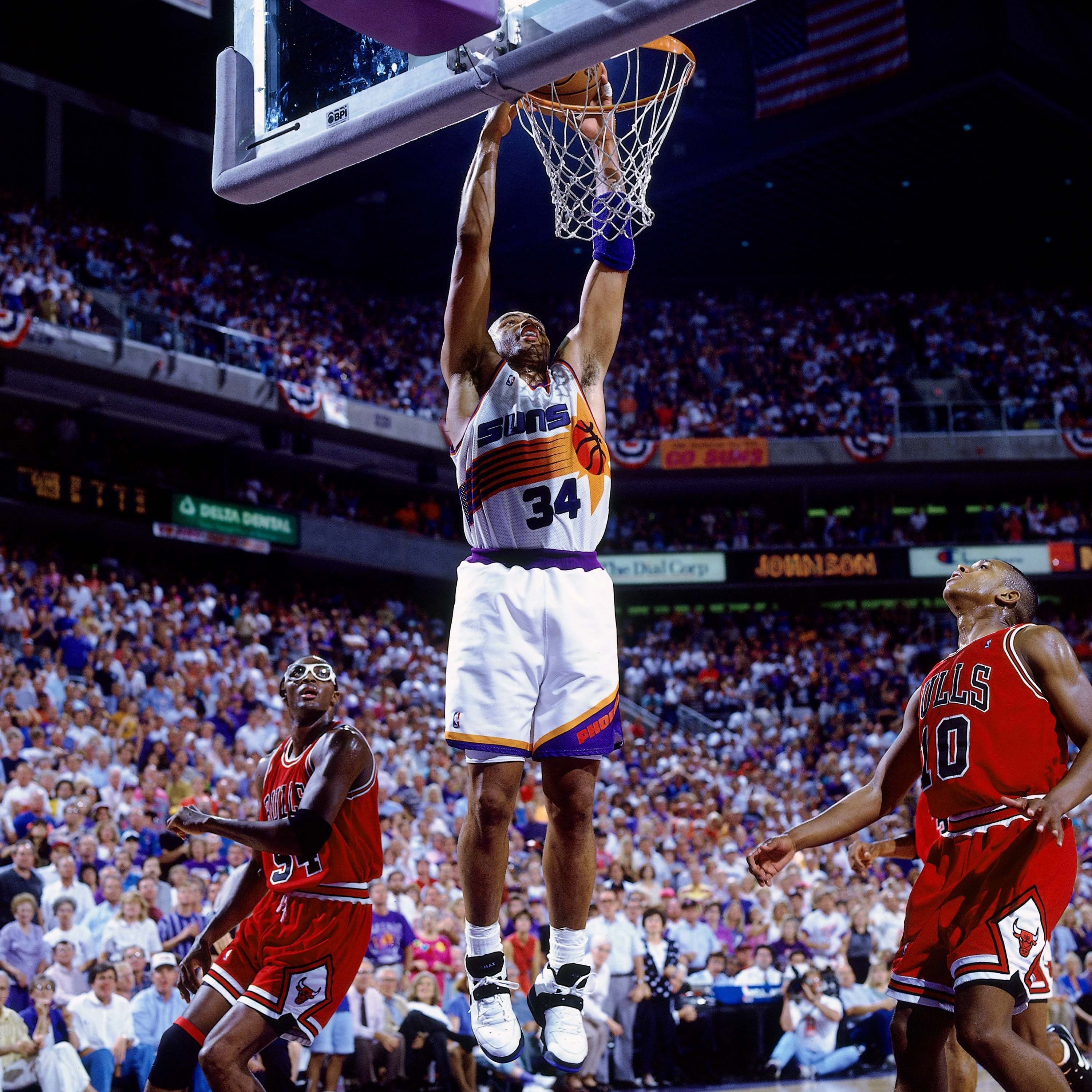
Charles Barkely #34 of the Phoenix Suns dunks in Game 2 of the NBA Finals against the Chicago Bulls at the America West Arena in Phoenix, Arizona, U.S., June 11, 1993. /VCG
Charles Barkely #34 of the Phoenix Suns dunks in Game 2 of the NBA Finals against the Chicago Bulls at the America West Arena in Phoenix, Arizona, U.S., June 11, 1993. /VCG
Johnson (2-8) continued to be baffled by Chicago's defense but Barkley began to slaughter every defender in front him – Grant, Pippen – via his post-up attack and athleticism. After the first half, Chicago led 59-53 but Barkley outscored Jordan 25-19.
The two super stars continued to take other sides' defense apart in the second half. The finals stats were Jordan 42+12+9 and Barkley 42+13+4. Phoenix led 106-105 in the last moment and Danny Ainge, the shooter who faced Jordan a year ago on behalf of the Portland Trail Blazers, tried to shoot an open 3-pointer before he was blocked by Pippen who already dropped a triple-double of 15+12+12.
The Suns lost both of their two home games. In ESPN's documentary for Jordan, "The Last Dance," Barkley recalled: "That was probably the first time in my life that I felt like there was a better basketball player in the world than me, to be honest with you."

Charles Barkley #34 of the Phoenix Suns drives towards the rim in Game 6 of the NBA Finals against the Chicago Bulls at th America West Arena, U.S., June 20, 1993. /VCG
Charles Barkley #34 of the Phoenix Suns drives towards the rim in Game 6 of the NBA Finals against the Chicago Bulls at th America West Arena, U.S., June 20, 1993. /VCG
However, on June 13, 1993, fans at the United Center witness one of the greatest OT games in NBA Finals history. The Suns led 99-88 when there were seven and a half minutes left in the fourth quarter, but the Bulls came back to the tie the game after a 15-4 run. The first OT was finished 107-107. In the second OT, the Bulls led for three times but watched Barkley and Majerle tie it again 114-114.
Then there was the third OT and Paul Westphal, head coach of the Suns, would not like it because he was with the Suns as a player in the last three-OT Finals game in 1976. That was Game 5 and the Boston Celtics beat the Suns 128-126.
Barkley did not let history repeat itself again. Thanks to the two 3-pointers and free throws made by him and Majerle, the Suns won Game 3 129-121. Barkley put down 24 points, 19 rebounds and four assists in 53 minutes. Majerle was 6-8 from downtown to get 28 points.
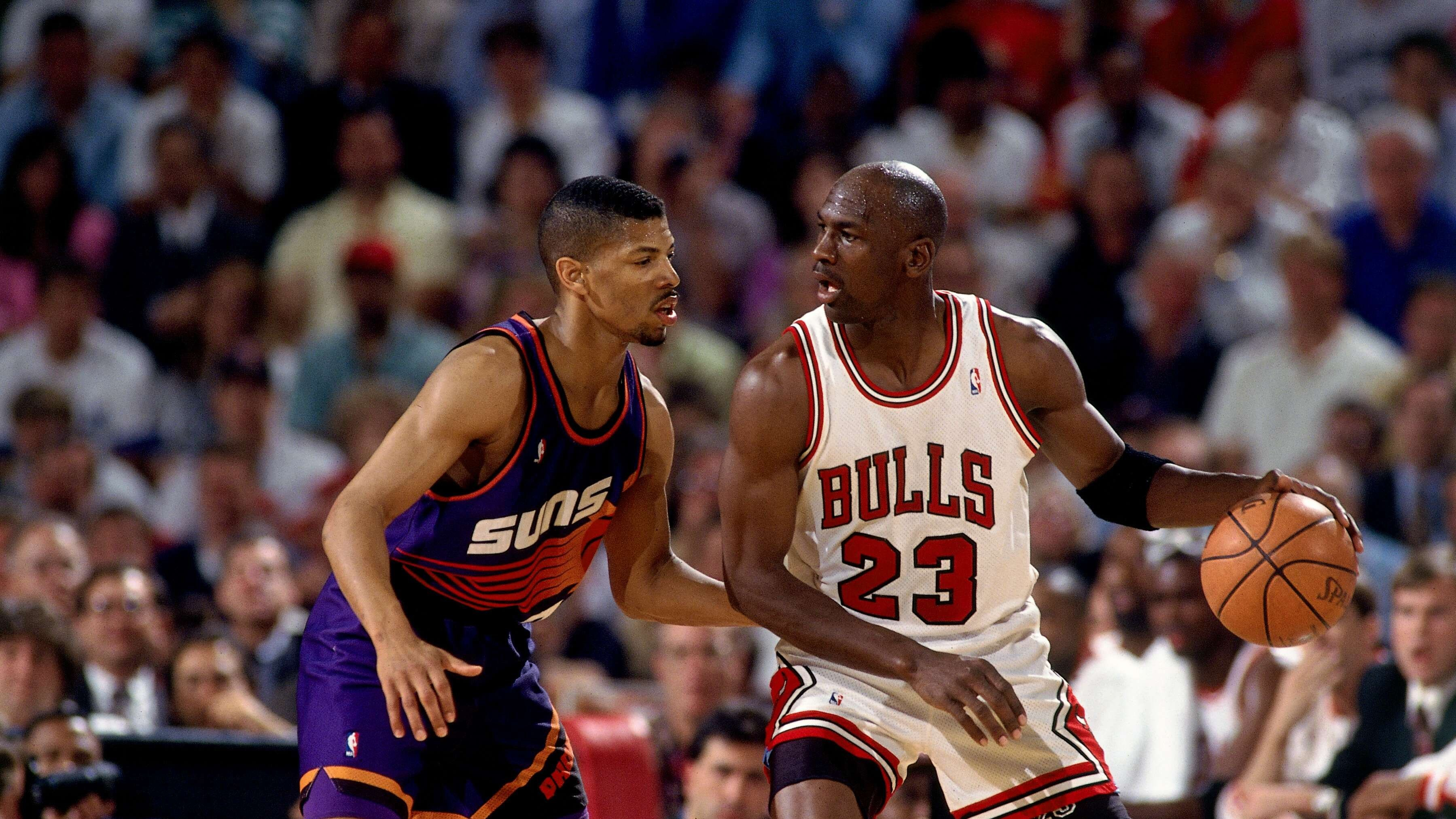
Kevin Johnson (L) of the Phoenix Suns defends Michael Jordan of the Chicago Bulls in Game 4 of the NBA Finals at the United Center, U.S., June 16, 1993. /VCG
Kevin Johnson (L) of the Phoenix Suns defends Michael Jordan of the Chicago Bulls in Game 4 of the NBA Finals at the United Center, U.S., June 16, 1993. /VCG
Jordan though scored 44 points, nine rebounds and six assists in 55 minutes, it took him 43 shots to do it. 1.85-meter tall Johnson because a surprising defensive success as he locked Jordan's lower body with his quick steps. By the way, Johnson played NBA record 64 minutes in this game.
He was so happy that he announced he found the way to stop Jordan after Game 3.
He really should have called Gerald Wilkins before he said that.
Game 4 became nightmare for the Suns' defense and the nightmare's jersey number was 23. From the beginning, he made four shots over Johnson's head – there's nothing the 1.85-meter guard could do to stop Jordan from making those fadeaway jumpers. So the Suns had to get taller Majerle to defend Jordan. Jordan's answer was four penetrations that were too fast for Majerle to follow. The Suns had Johnson back, then Jordan continued to make jumpers.
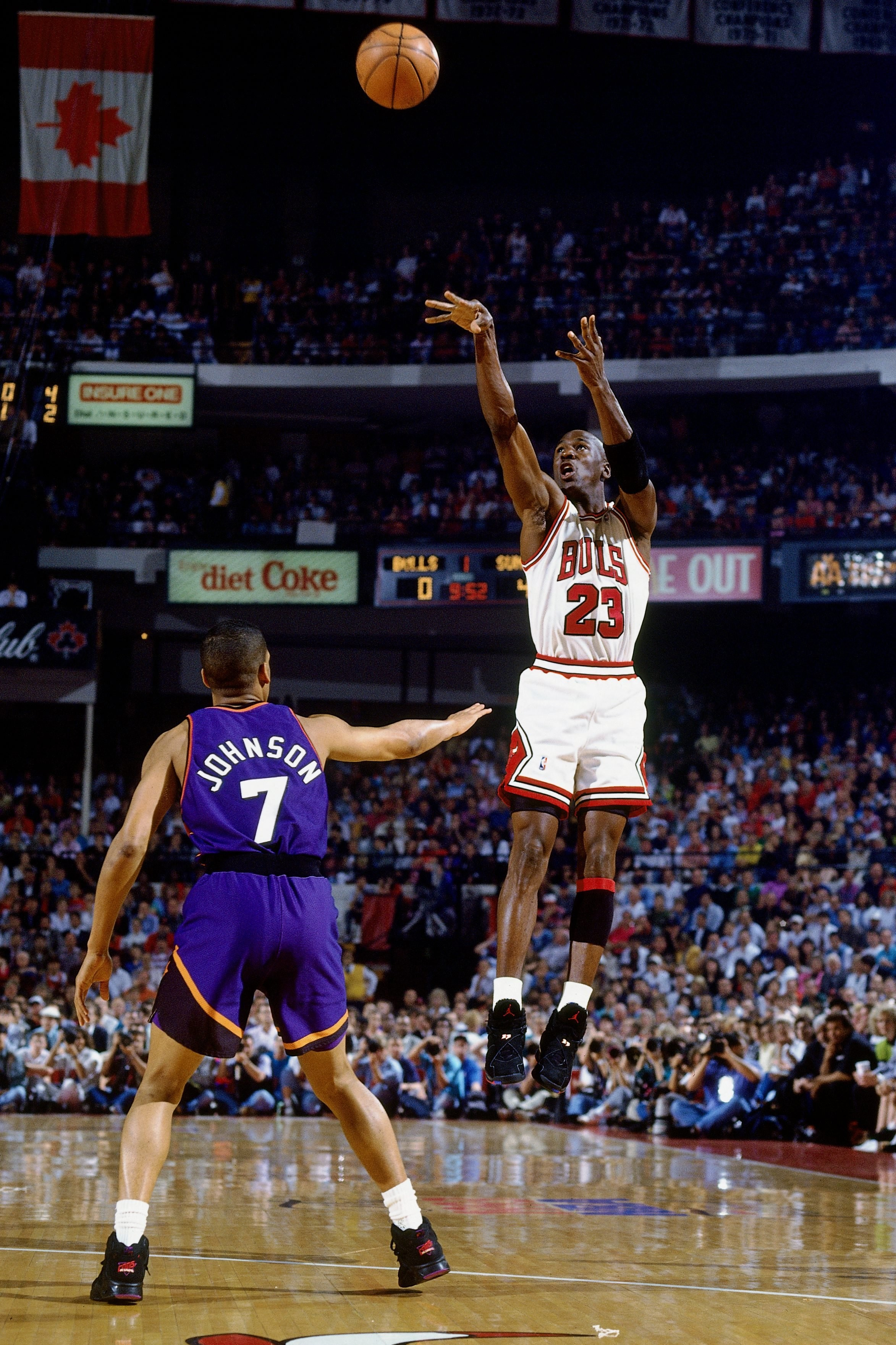
Michael Jordan #23 of the Chicago Bulls shoots the ball over the head of Kevin Johnson of the Phoenix Suns in Game 5 of the NBA Finals at the United Center, U.S., June 18, 1993. /VCG
Michael Jordan #23 of the Chicago Bulls shoots the ball over the head of Kevin Johnson of the Phoenix Suns in Game 5 of the NBA Finals at the United Center, U.S., June 18, 1993. /VCG
In the first half, the Bulls' No. 23 was 14-20 to get 33 points. He continued to take the opponents' defense apart with every weapon in his arsenal. In the last 30 seconds, the Bulls led 106-104. Jordan got the ball, the Suns' double teaming could not stop him. Jordan was in the air about to meet 114-kilometer Barkley, who punched Bill Laimbeer in Philadelphia a few years go.
The two collided with each other and Barkley fell to the ground first. He was lying there, watching Jordan throw the ball into the net while the referee called a foul. Jordan made the free throw to finish a three-point play.
In the end, Chicago won 111-106 and Jordan put down 55 points eight rebounds and four assists – the second-highest points in NBA history following Elgin Baylor's 61.
"What he did tonight," said Westphal, "was inflict his will on this ballgame."
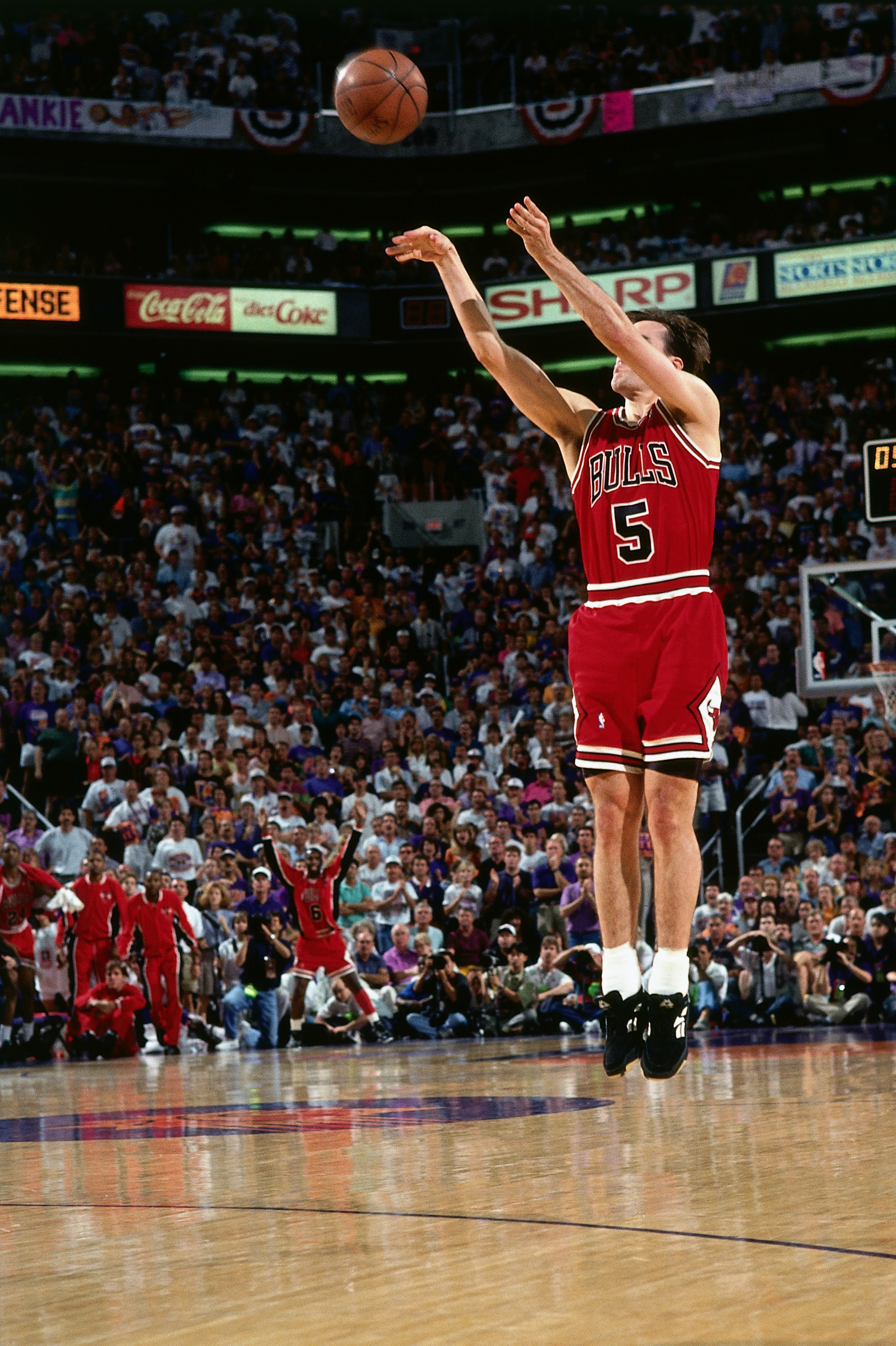
John Paxson of the Chicago Bulls shoots the game-winning 3-pointer in Game 6 of the NBA Finals against the Phoenix Suns at the America West Arena, U.S., June 20, 1993. /VCG
John Paxson of the Chicago Bulls shoots the game-winning 3-pointer in Game 6 of the NBA Finals against the Phoenix Suns at the America West Arena, U.S., June 20, 1993. /VCG
Nonetheless, before Bulls fans could celebrate their third title, Barkley and the Suns ruined their party again. Richard Dumars became the team's ingenious move as he went 12-14 to get 25 points in 30 minutes. 108-98, the Suns won. Though they trailed 3-2 in the series, the rest two games would happen at their home.
Jordan extended his 40+point game to four in a row and decided to encourage his teammates in a new way. He was wearing sunglasses and a vacation-colored shirt with a cigar in his mouth, said to the rest of the team: " Hello, world champs, let's go to Phoenix and kick some a**."
In Game 6, Jordan and Pippen took over respectively in Q1 and Q3, but the Suns continued to come back. When the game entered the fourth quarter, something went wrong. The Bulls only scored one point in seven minutes and watched the Suns took the lead 91-88 with a 12-1 run.
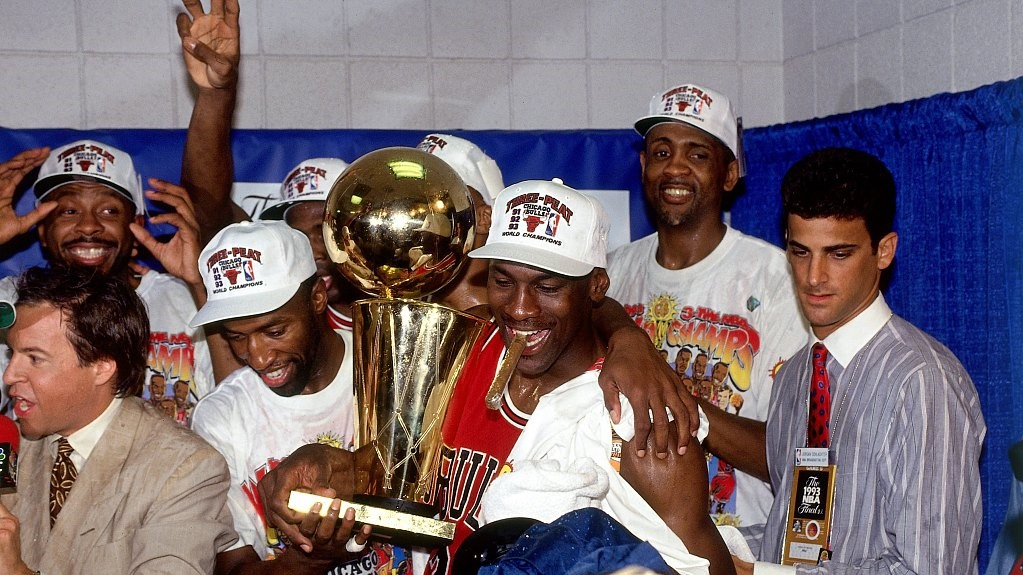
Michael Jordan (C) of the Chicago Bulls celebrates with the Larry O'Brien NBA Championship Trophy after defeating the Phoenix Suns 99-98 in Game 6 of the NBA Finals at the America West Arena, U.S., June 20, 1993. /VCG
Michael Jordan (C) of the Chicago Bulls celebrates with the Larry O'Brien NBA Championship Trophy after defeating the Phoenix Suns 99-98 in Game 6 of the NBA Finals at the America West Arena, U.S., June 20, 1993. /VCG
The Bulls only had Jordan to rely on. The No. 23 scored eight points – in fact, all of the team's nine points so far came from him. Then there came the last possession, Jordan approached the 3-point line with the ball. He passed it to Pippen who then gave it to Grant. Ainge switched to defend him, so Grant passed the ball to 32-year-old John Paxson outside the 3-point line.
The shooter who went 8-8 in Game 5 of the 1991 Finals received the ball, shot and made it. 99-98, Chicago with the lead. Grant then blocked Johnson's shot. 99-98, Chicago and Jordan won their third straight NBA championship. Jordan averaged 41 points, 8.5 rebounds, 6.3 assists and dropped four 40+point games in a row, both NBA records.
Jordan was the first three-time Finals MVP in league history before Tim Duncan and O'Neal did it more than 10 years later. He beat everyone, he was the winner, and he retired to play baseball.